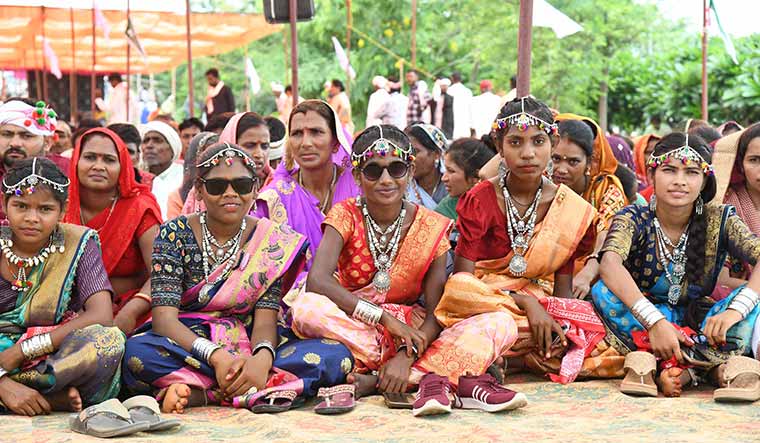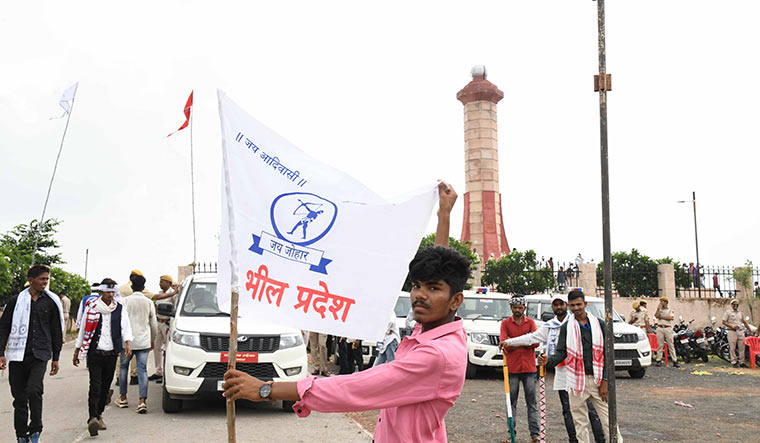A rain-washed day is unfolding and the verdant hills and meadows of Banswara are resplendent in their green finery. Though the humidity makes it oppressively warm, the winding road leading up to the monument of Mangarh Dham is abuzz with a festival-like atmosphere. The monument has immense social and historical importance for the Bhil tribe, and the energy-sapping weather does not stop them from trudging up the hill. Many of them carry decorated bows and arrows. The mood is celebratory as groups of people arrive playing traditional musical instruments and singing joyously.
Banswara is a stark contrast to the arid terrain of Rajasthan. It is also the setting of an intense social and political churn. The mobilisation of Bhils as a group keen to assert its identity is evident as they gathered in massive numbers at the Mangarh Dham, built in remembrance of the 1,500 Bhils who were killed by the British in 1913.
Over a lakh Bhils gathered at Mangarh Dham on July 18 demanding Bhil Pradesh, a separate state for the tribal community that will comprise 43 Bhil-dominated districts in Rajasthan, Gujarat, Madhya Pradesh and Maharashtra. It is not a new demand, but has grown louder of late, as a campaign is on in the tribal-dominated districts to mobilise the Adivasis as a socially and politically aware group. The movement has now got an electoral boost, with the Bharat Adivasi Party, formed in September 2023, winning three assembly seats in Rajasthan and one in Madhya Pradesh, and also the Banswara Lok Sabha seat.
“Our main aim is creation of Bhil Pradesh,” said Rajkumar Roat, BAP’s Lok Sabha member from Banswara. “If this demand is accepted, all the issues can be resolved. Minerals are found in tribal areas, but the tax collected is disbursed in such a manner that this region is neglected. Even today, you will come across many schools where children of three to four classes sit together. Malnutrition is common. The tribals have been living in this region since pre-independence times, but they still have not got ownership of the land.”
The districts of Banswara and Dungarpur have been the epicentre of this agitation. What began as an assertion of the tribal identity in student politics took the form of an ideological forum called the Adivasi Parivar. The next step was their entry into electoral politics. The Adivasi Parivar contested the 2018 Rajasthan assembly elections under the banner of the Bharatiya Tribal Party, a Gujarat-based party founded by tribal leader Chotubhai Vasava, and won two seats. Rajkumar, one of the two winners, was the youngest member to get elected to the Vidhan Sabha. In September 2023, however, the Rajasthan leaders broke away from the BTP.
“We first applied for the name National Tribal Party,” said Kantilal Roat, one of the founding leaders of the BAP and the party’s national general secretary. “Governments and the established political parties did not want us to get registered as a political party. We gave other names, and finally the name Bharat Adivasi Party was cleared.”
The BAP was launched in September 2023 at a rally in Genji Ghata village of Dungarpur. It was allotted the symbol of hockey stick and ball, which the BAP leaders say is apt as it acts as a reminder of hockey great Jaipal Singh Munda, a tribal icon. It fielded 27 candidates in Rajasthan and eight in Madhya Pradesh in the assembly elections in December 2023, and won three and one, respectively. The breakthrough, however, was the party’s arrival on the national scene when Rajkumar won the Banswara Lok Sabha seat. He defeated the BJP’s Mahendrajeet Singh Malviya, who had defected from the Congress earlier this year. The cherry on the cake was the victory in the by-election in Bagidora, which had been vacated by Malviya to contest the Lok Sabha poll.
The party has around 2.5 lakh members and is building organisation in eight states―Rajasthan, Gujarat, Madhya Pradesh, Maharashtra, Jharkhand, Chhattisgarh, Andhra Pradesh and Assam, and the union territory of Dadra and Nagar Haveli. “We had been carrying out a social awareness campaign since 2015,” said BAP president Mohanlal Roat. “We were accused of being anti-democratic and were labelled naxalites. That is when we decided we had to take the electoral plunge. We are not going to limit ourselves to raising the issues of the 30 lakh Bhils in Rajasthan. The issues we have raised go beyond the borders of Rajasthan.”
 Fair share: Bhil women at Mangarh Dham | Sanjay Ahlawat
Fair share: Bhil women at Mangarh Dham | Sanjay Ahlawat
The campaign to counter what was described as Hinduisation of tribals has been central to the BAP’s political campaign and the social movement of Adivasi Parivar. “The RSS has, through lies and allurement, tried to make the Bhils believe that they were Hindu. But lies cannot survive for long. Our gods are different. Our rituals are different. Our religious ceremonies meant to mark crucial life events such as birth, death or marriage are different,” said Mohanlal.
Traditionally, the Bhils are nature worshippers. Also, every village has its own deity. Worship of ancestors is also an integral part of the Bhil faith. Recently, there was a controversy over Rajasthan Education Minister Madan Dilawar’s remarks that Rajkumar should get his DNA checked to verify if he was the son of a Hindu. In protest, a large number of BAP workers marched to Dilawar’s residence in Jaipur holding blood samples.
The cultural distinction of tribals is being emphasised in the new movement. Bhil women, for instance, are encouraged not to cover their faces. They had adopted the ghoonghat (veil) because of the Rajput influence. “Bhil women traditionally had an equal status in society. They were not required to cover their faces,” said Anutosh Roat, district president of the BAP in Dungarpur.
The legacy of the Bhil warrior Rana Punja, whose statues and paintings dot the region, best represents the socio-political campaign to assert Adivasi pride. Bhil leaders claim that Rana Punja, who fought alongside the Mewar hero Maharana Pratap against the Mughals, did so to protect the land and reject the religious angle given to the fight.
The campaign is also about the rights of the Bhils over the resources of the region. “Our fight is for jal, jungle, jameen (water, forest and land),” said Kantilal. “The tribals have the first right over resources. Our constitutional rights due to us are not provided to us.”
The tribal leaders point out that the region scores very low on the human development index. A common complaint is of neglect of schools―most of them do not have the basic infrastructure or enough teachers. Dharti Mata School in Baiyoda in Dungarpur, for instance, functions in a building that has been declared unsafe by the authorities.
Unemployment is another big issue. Many families have their menfolk working in Gujarat or Maharashtra. “My husband has been working in Gujarat for the past ten years,” said Surta Devi, whose husband is a casual labourer in Ahmedabad. She lives with her four children in a modest house in Herata village in Dungarpur. “He has been staying away from his family, his home, his children, but there is no option because we will starve otherwise,” she says.
The success of the party is driven by the youth. Young and charismatic leaders like Rajkumar and Kantilal enjoy massive following among them.
The BAP wants to be seen as equidistant from the BJP and the Congress. While its leaders have been vocal in their criticism of the alleged efforts of the right-wing organisations to diminish the tribal identity, they also say that the Congress has not done enough to address the problems of the Bhil community. The Congress had supported Rajkumar in the Lok Sabha election. “They helped us because of the circumstances,” said Mohanlal. “When the Ashok Gehlot government was in crisis, our two MLAs had helped them. It is like a loan repaid.”
The BAP’s growing influence in the region is not lost on the national parties. In November 2022, Prime Minister Narendra Modi declared Mangarh Dham a national monument in the presence of the then chief minister Gehlot at an event held at the hilltop memorial. The defection of Malviya, a tall leader in the region, before the Lok Sabha elections was an attempt by the BJP to deal with the popularity of the BAP. The Congress’s decision to support Rajkumar also has to be seen in the same context.
The newest party is indeed making waves.


